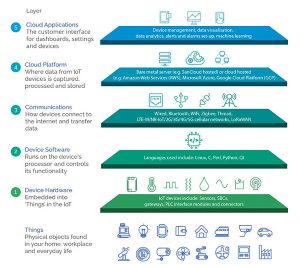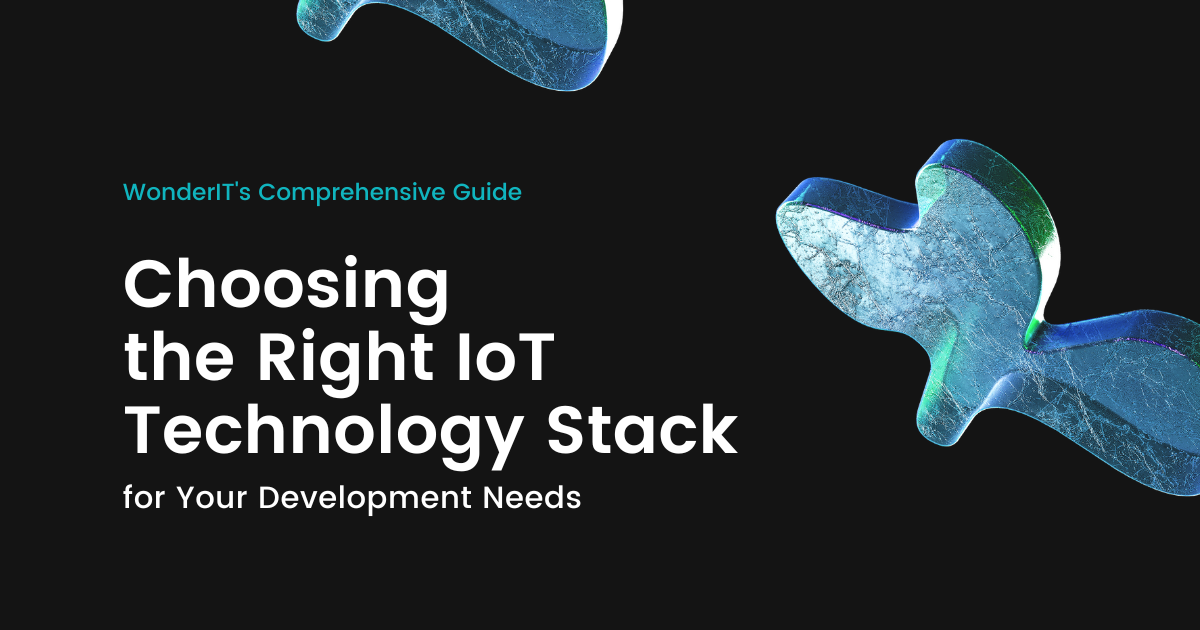Learn how to choose the perfect IoT technology stack to achieve your objectives successfully. WonderIT’s comprehensive guide explores the key considerations for selecting the right stack, ensuring seamless connectivity, robust security, and efficient data processing.
Introduction
Today, the Internet of Things (IoT) has emerged as a transformative technology, revolutionising the way we interact with smart devices and data. As businesses seek to leverage the potential of IoT, selecting the right technology stack becomes paramount to ensure seamless connectivity, robust security, and efficient data processing. Our software company WonderIT, offers comprehensive IoT development services, guiding businesses in choosing the ideal IoT technology stack.
In this article, we will explore the key considerations and benefits of selecting the right IoT technology stack to achieve your development objectives successfully.
Understanding the IoT Technology Stack
Before delving into the intricacies of choosing an IoT technology stack, it is essential to comprehend its components and their role in IoT development. An IoT technology stack encompasses multiple layers, including:
Device Layer – This layer comprises connected devices such as sensors, actuators, and gateways responsible for collecting and transmitting data.
Communication Layer – The communication layer facilitates the seamless flow of data between devices and the cloud. It includes protocols like MQTT, CoAP, and HTTP.
Cloud Platform – The cloud platform acts as the central repository for IoT data, enabling storage, processing, and analysis. It forms the backbone of any IoT project
Application Layer – The application layer includes the frontend and backend applications that interact with users and devices, providing meaningful insights and functionality.

Key Considerations for Choosing an IoT Technology Stack
Scalability
Scalability is a critical factor when selecting an IoT technology stack. As your IoT project grows and accommodates more devices and data, the stack should seamlessly handle increased traffic and processing demands. Consider opting for cloud-based solutions that offer elastic scalability, allowing you to expand your infrastructure effortlessly.
Interoperability
To create a cohesive IoT ecosystem, ensure that the technology stack components can communicate effectively with each other. Interoperability guarantees smooth data exchange and streamlined processes, avoiding compatibility issues between different hardware and software components.
Security Features
As IoT devices gather and transmit sensitive data, robust security measures are paramount. Choose a technology stack that offers strong encryption, authentication, and authorization mechanisms to safeguard against potential cyber threats and data breaches.
Latency and Real-Time Capabilities
For certain IoT applications, low latency and real-time data processing are crucial. Consider whether your chosen technology stack can meet the latency requirements of your specific use case, such as real-time monitoring or control applications.
Cost-effectiveness
Cost considerations play a vital role in any technology decision. Evaluate the pricing models of different technology stack options and balance them with the features and performance they offer. Remember to account for long-term expenses, including maintenance and upgrades.
Developer Community and Support
Opting for a technology stack with an active and robust developer community can be advantageous. This ensures that you can find helpful resources, documentation, and support when facing challenges during development.
Flexibility and Customization
Each IoT project has unique requirements, and the chosen technology stack should be flexible enough to adapt to these specific needs. Consider a modular approach that allows customization and integration with existing systems.
Data Management and Analytics
The ability to efficiently manage, analyse, and derive insights from IoT data is crucial for making informed decisions. Choose a technology stack that offers robust data management and analytics capabilities to harness the full potential of your collected data.
Recommended IoT Technology Stack Components
Now that we know what to look for, let’s explore some of the popular IoT technology stacks in the market:
Devices and Sensors
- Raspberry Pi: A versatile and cost-effective single-board computer suitable for a wide range of IoT applications.
- Arduino: An open-source microcontroller platform ideal for projects requiring low-power consumption.
Connectivity
- MQTT: A lightweight messaging protocol designed for efficient communication between IoT devices and the server.
- LoRaWAN: A long-range, low-power wireless communication technology suitable for IoT deployments over large areas.
Data Processing
- Apache Kafka: A high-throughput, distributed messaging system for handling massive volumes of data streams.
- Apache Spark: A fast and general-purpose cluster computing system for real-time data processing.
Cloud Platform
- AWS IoT Core: A managed cloud service by Amazon Web Services for securely connecting and managing IoT devices.
- Google Cloud IoT Core: A fully managed service by Google Cloud for connecting, managing, and ingesting data from IoT devices.
Application Layer
- Node.js: An event-driven, non-blocking JavaScript runtime, perfect for building scalable, real-time applications.
- React: A popular JavaScript library for building interactive user interfaces and single-page applications.
Security
- Secure Sockets Layer (SSL): A standard security protocol that ensures encrypted communication between devices and servers.
- OAuth 2.0: A widely-used authorization framework that enables secure access to resources without sharing credentials.
Selecting the Right IoT Technology Stack for Your Project
To choose the best IoT technology stack for your project, consider the specific requirements and constraints of your IoT application. If you’re building a consumer-oriented IoT product, ease of use and quick development may be essential, making platforms like Arduino or Particle good options.
On the other hand, for industrial IoT applications that demand robust security and scalability, cloud-based solutions like AWS IoT Core or Azure IoT Hub may be more suitable.
Book a Consultation with WonderIT
At WonderIT, we understand that choosing the right IoT technology stack can be a critical decision that significantly impacts the success of your IoT development project. Our team of expert IoT developers is here to help you navigate through the complexities and make informed decisions for your specific needs.
Whether you have a clear vision of your IoT project or need guidance in formulating your ideas, our services can provide you with valuable insights and recommendations tailored to your business requirements. Take the next step towards transforming your IoT project into reality with WonderIT today.
The Future of IoT Technology Stacks
As the Internet of Things continues to advance, the IoT technology stack is constantly evolving. New innovations and improvements are being made to address the increasing demands of IoT applications. Here are some key trends that are shaping the future of IoT technology stacks:
Edge Computing Integration
Edge computing is gaining popularity in the IoT world as it offers the advantage of processing data closer to the source of generation. By integrating edge computing capabilities into IoT technology stacks, developers can reduce latency, minimise bandwidth usage, and enhance overall system performance. This trend is particularly significant for real-time applications, such as autonomous vehicles and industrial automation.
Artificial Intelligence and Machine Learning
The combination of IoT and AI/ML has immense potential to transform various industries. AI-powered IoT technology stacks can analyse vast amounts of data from IoT devices, enabling smart decision-making, predictive maintenance, and personalised user experiences. Integrating AI and ML capabilities into the technology stack can unlock a new level of efficiency and automation.
5G Connectivity
The rollout of 5G networks promises faster and more reliable communication between IoT devices and the cloud. IoT technology stacks will need to adapt to take full advantage of 5G’s low latency and high bandwidth to enable seamless real-time applications and support a massive number of connected devices.
Blockchain for Enhanced Security
Blockchain technology offers an immutable and decentralised approach to secure data storage and communication. By integrating blockchain into IoT technology stacks, developers can ensure the integrity and authenticity of data, making it more challenging for malicious actors to tamper with information.
Customization and Modularity
As IoT applications become more diverse and specialised, the need for customised technology stacks grows. Future IoT technology stacks will likely provide modular components that developers can mix and match to tailor solutions to specific use cases, promoting greater flexibility and cost-effectiveness.
Energy Efficiency
IoT devices often operate on limited power sources, such as batteries. Future technology stacks will prioritise energy efficiency, optimising data transmission and processing to extend the battery life of IoT devices, reducing maintenance and operational costs
Security by Design
With the increasing number of IoT devices being connected to the internet, security must be a fundamental aspect of any technology stack. Future IoT technology stacks will be built with security as a core principle, implementing secure communication protocols, strong authentication mechanisms, and regular updates to protect against emerging threats.
Conclusion
As the Internet of Things continues to drive innovation and transform industries, choosing the right IoT technology stack becomes imperative for successful development. WonderIT’s IoT development services offer unparalleled expertise in guiding businesses to select the ideal technology stack that aligns with their project requirements, scalability needs, and long-term objectives. With a wide range of technology stacks, including Raspberry Pi with Python, Arduino with C/C++, AWS IoT Core, Microsoft Azure IoT Suite, and Google Cloud IoT Core, WonderIT ensures seamless connectivity, robust security, and real-time data processing to unlock the full potential of your IoT project.
Experience the wonder of IoT development with WonderIT today and witness your ideas transform into reality!


Recent Comments